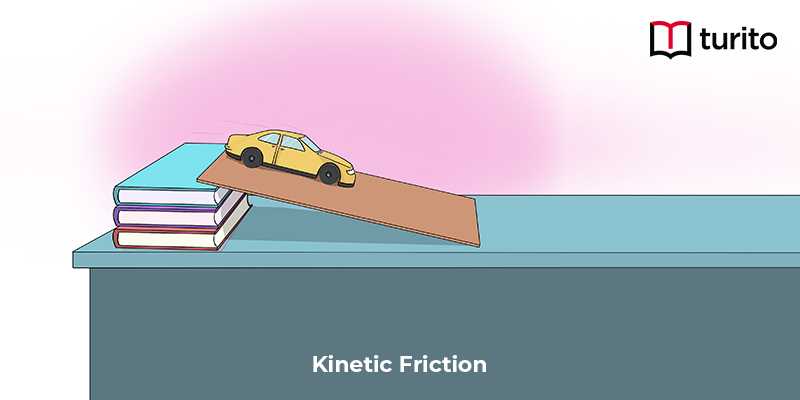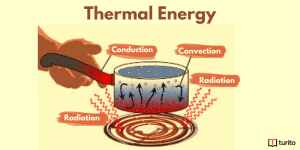Kinetic Friction
Kinetic force is a force acting between two surfaces in motion. A force is experienced by a body moving on the surface that is opposite to the direction of its motion. The magnitude of the force is dependent on the kinetic friction coefficient between the two materials.
What is Kinetic Friction?
Friction can be described as the force holding a moving object back. Kinetic friction interferes with the movement of multiple objects and is a part of everything in motion. The force is incident in a direction opposite to the sliding motion of an object.
Things are not as we assume; even seemingly smooth surfaces are actually microscopic terrain of minuscule hills and valleys that are too small to perceive but have a significant impact on determining the relative velocity of two touching surfaces. The frictional force, which arises from the interaction of these minute surface flaws, acts counterclockwise to any movement and must be calculated to establish the net force acting on the object.
There are several different types of friction, but kinetic friction—also known as sliding friction—affects an object before it begins to move, static friction affects an object before it begins to move, and rolling friction specifically affects rolling things like wheels.
For example, if a vehicle has to come to a halt, brakes are applied, and that is where the kinetic friction starts acting. If a person is walking and wants to come to a halt suddenly, again, it is the friction that comes into play. However, if we have to come to a halt in the middle of a puddle, things start getting more challenging as the friction there is less and won’t help much.
Kinetic Friction Formula
The kinetic friction coefficient is represented by the Greek symbol “mu” (μ), with “k” as a subscript. The kinetic friction force is μk times that of the normal force acting on the body. It is represented in terms of Newtons. The equation for the kinetic friction can be written as:
Kinetic friction force = normal force * kinetic friction coefficient
Fk= μk η
In the above equation,
Fk stands for the kinetic frictional force
η represents the normal force
μk stands for the coefficient of kinetic friction
Friction Types
Friction is mainly of two types— Kinetic friction and static friction.
Suppose we need to overcome the static friction acting between the two surfaces. In this case, we need to remove both the molecular obstacles and, to a certain extent, the mechanical obstacles as well. Once we initiate a movement, there is the continuation of some abrasion but at a lower level than what happens during static friction. The relative velocity between the two surfaces provides a time that is insufficient for the occurrence of additional cold welding, except for the case when the velocity is extremely low.
As most of the abrasion and adhesion are overcome for the induction of movement, there is a decrease in the motion resistance between two surfaces. The movement of these two surfaces is now influenced by kinetic friction, whose value is much lower than that of static friction.
Laws of Kinetic Friction
The four laws of friction have been explained below:
First law: There is a direct relationship between the kinetic frictional (Fk) and the reaction (N) between two bodies in contact with each other. Where μk is a constant called the kinetic friction coefficient.
Second law: The kinetic frictional force does not depend on the shape and apparent area of the surfaces that are in contact.
Third law: This law depends on the material and nature of the surface that is in contact.
Fourth law: This law does not depend on the object’s velocity that is in contact. But, it is applicable only when the relative velocity between the surface and the object is not very large.
Derivation for the Formula of Kinetic Friction
Consider a weight block mg that lies on a horizontal surface, as represented in the figure. A surface gets deformed (even if it is rigid) if a body is pressed against it. The body is pushed by the deformed surface by a normal force, R, that acts at right angles to the surface. This force is referred to as the normal reaction force.
Now consider a force P is exerted on the weight block. The body remains clearly at rest as another force, F in the horizontal direction, comes into play in the opposite direction so that the resultant net force on the body is zero. This force F that acts along the body’s surface that is in contact with the table’s surface is known as the frictional force. As long as the body is at rest, F = P, meaning if P is increased, friction F also increases while always remaining equal to P.
As the applied force is slightly increased beyond the limiting frictional force, the motion of the body starts. However, this does not imply that the
frictional force has disappeared. It only implies that the limiting friction has been overcome by force. At this stage, the frictional force is known as Dynamic friction or Kinetic friction. In other words, dynamic friction is the opposing force acting on a body when a body is moving over another body’s surface.
Differentiate Between Static and Kinetic Friction
|
Static Friction | Kinetic Friction |
|
The friction present between two or more bodies that are not in motion with respect to each other is called static friction. |
The friction present between two or more bodies that are moving with respect to each other is called kinetic friction. |
|
As the value of the coefficient of static friction is higher, its magnitude is greater. |
As the value of the coefficient of kinetic friction is lower, its magnitude is comparatively lesser. |
|
The equation for static friction is: |
The equation for kinetic friction is: |
The frictional force is a force that resists the relative motion between two objects, and it is experienced by two bodies at their interface. In the case of fluids, friction is also experienced within the bodies. Leonardo da Vinci first gave the concept of friction coefficient. The coefficient of friction’s magnitude is determined by the features of the surroundings, surfaces, presence of lubricant, etc.
Applications of Kinetic Friction
Below are some real-life examples of kinetic friction:
- Friction has a huge role to play in daily occurrences, such as when a rubbing motion between two objects occurs. The motion that results from changes into heat, thus giving rise to fire in some cases.
- Friction is the culprit behind wear and tear. That is why we are required to oil machines to lubricate them to reduce the friction. When rubbing between two objects occurs, frictional force converts into thermal energy.
Sample Problems Based on Static and Kinetic Friction
1: A large cardboard of mass 75.0 kg is pushed by a man across the floor. If the kinetic friction coefficient is 0.520 and the worker exerts a force of 400 N in the forward direction, calculate the magnitude of the frictional force.
The normal force of a body on a flat surface can be determined by the formula:
η = mg
If we substitute the value of η in the equation Fk = μk η, we get
Fk= 0.520 * 75.0kg * 9.80m/s2 = 382.2N
2: Taking the values from the question above, calculate the net force that moves the box.
The net force that acts on an object is a combination of all the forces that act on the object.
In this scenario, the forces that act on the body are the forces exerted by the kinetic friction and the man acting in the opposite direction.
If we consider the forward motion to be positive, then the net force can be calculated as:
Fnet = Fworker – Fk
If we substitute the values in the above equation, we will get
Fnet = 400 N – 382.2 N = 17.8 N
3: Why is friction experienced by a rolling motion?
In theory, a point of contact is made with the surface by a ball.
However, in actuality, the ball (and the surface) deforms because of the effect of the load, and the shape of the contact area changes to elliptical.
In theory, rolling surfaces, like those found in most linear and rotary bearings (except plain bearings), should not have to face frictional forces.
However, in real-world, the friction in rolling surfaces is caused by three factors:
- Presence of micro-slip between the surfaces makes them slide relative to each other.
- Inelastic characteristics of the materials
- The surfaces’ roughness
Conclusion
In conclusion, kinetic friction definition is that it is the force acting between two surfaces in motion. A body in motion on a surface feels a force in a direction opposing its motion. This force’s magnitude depends on the kinetic friction coefficient between the two materials.
We can easily define friction as the force holding a sliding object back.
Frequently Asked Questions
1. What is friction?
Friction can be defined as a force opposing the sliding or rolling of a solid surface over another solid surface.
2. What are the types of friction?
There are two types of friction— kinetic and static friction.
3. What do you mean by kinetic friction?
Kinetic friction is friction acting between two moving surfaces.
4. What do you mean by static friction?
Static friction is friction acting between two non-moving surfaces.

Relevant Articles
Understanding Thermal Energy: What It Is and How It Works
Thermal energy is essential to our daily lives, from warming …
Understanding Thermal Energy: What It Is and How It Works Read More »
Read More >>Avogadro’s Number: Meaning, Importance, and More
Introduction The concept of measuring the microscopic particles that make …
Avogadro’s Number: Meaning, Importance, and More Read More »
Read More >>
























Comments: